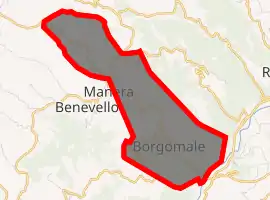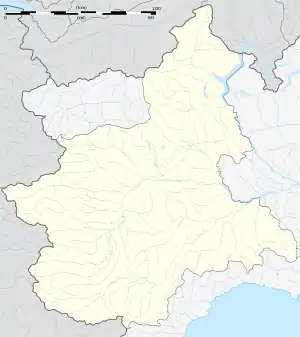Borgomale
Borgomale is a comune (municipality) in the Province of Cuneo in the Italian region Piedmont, located about 60 kilometres (37 mi) southeast of Turin and about 50 kilometres (31 mi) northeast of Cuneo.
Borgomale | |
|---|---|
| Comune di Borgomale | |
Location of Borgomale 
| |
 Borgomale Location of Borgomale in Italy  Borgomale Borgomale (Piedmont) | |
| Coordinates: 44°37′N 8°8′E | |
| Country | Italy |
| Region | Piedmont |
| Province | Cuneo (CN) |
| Government | |
| • Mayor | Massimo Antoniotto |
| Area | |
| • Total | 8.4 km2 (3.2 sq mi) |
| Population (30 November 2017)[2] | |
| • Total | 389 |
| • Density | 46/km2 (120/sq mi) |
| Time zone | UTC+1 (CET) |
| • Summer (DST) | UTC+2 (CEST) |
| Postal code | 12050 |
| Dialing code | 0173 |
Borgomale borders the following municipalities: Alba, Benevello, Bosia, Castino, Lequio Berria, and Trezzo Tinella.
The 15th century castle in the village was formerly owned by the Falletti Marquises of Barolo. It was built on an existing fortification. It became a residential place after the passage of Borgomale to Casa Savoia (1631, Peace of Cherasco), and figures among the "Open Castles" of Lower Piedmont.
The name of the village is connected with the concept of 'apple tree' (Italian melo) and/or 'apple' (Italian mela) and the current denomination of the village, with '-male' ('bad', 'evil'), derives from a bona fide paretimology produced over time by the local speakers and due to the confusion between Latin mălum, 'bad ', 'evil', and Latin mālum, 'apple 'and/or 'apple tree'. Borgomale was originally 'the village of apples', or 'the village of the apple trees', and, over time, it became 'the bad village', or 'the village of evil', due to the misunderstanding of the vowel 'quantity' of the Latin lexemes related to its toponym.[3]
References
- "Superficie di Comuni Province e Regioni italiane al 9 ottobre 2011". Istat. Retrieved 16 March 2019.
- All demographics and other statistics: Italian statistical institute Istat.
- Francesco Perono Cacciafoco, Francesco Cavallaro, and František Kratochvíl, Diachronic Toponomastics and Language Reconstruction in South-East Asia According to an Experimental Convergent Methodology: Abui as a Case Study, in Review of Historical Geography and Toponomastics, vol. 10, nº 19-20, 2015, pp. 32-34.
